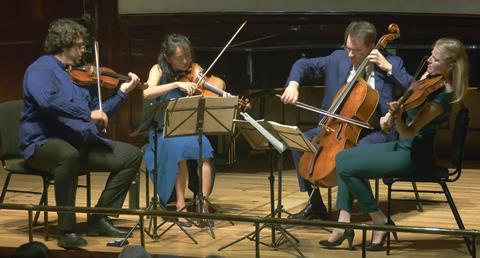Tim Homfray hears the performance of Schumann, Britten and Beethoven at London’s Wigmore Hall on 15 July 2024

The Doric Quartet produced great conversational playing in the first movement of Schumann’s A major Quartet op.41 no.3, a lively discourse full of shifting character, sometimes fervent, at other times questioning. There was a nervy pulse to the Assai agitato until cellist John Myerscough launched the energetic fugato, urgent and hectic. The final Tempo risoluto section was even more forceful – with the musicians playing as if their lives depended on it. They squeezed the dissonances in the central part of the Adagio molto as first violin and viola passed the compact figure between them, progressing to fierce emotional climaxes. The finale was an exhilarating ride in which all four appeared to be having a great time.
Read: The Doric Quartet on switching to Classical bows
The opening March of Britten’s Three Divertimenti was a splendid aural picture ranging from manic to pointillist. There were touches of nursery naivety in the Waltz, and the Burlesque had an edge of spiky accented menace.
In the first movement of Beethoven’s E minor Quartet op.59 no.2 leaping vitality and aggressive muscularity would turn on an instant to beguiling lyricism. The broad spans within the second-movement Molto adagio were definitively shaped and surely paced. The Thème russe of the third movement was quite gentle and jaunty to start with, then grew into a force to be reckoned with, and the finale went at a rollicking lick.
TIM HOMFRAY























































No comments yet